Samsung S85D is Samsung's entry-level OLED model for 2024, but it certainly does not come across as "budget". From the very first contact, the television demonstrated that OLED technology makes a difference. The deep blacks, excellent contrast and great viewing angles make watching favourite films and series pure pleasure, no matter where we are sitting. It is a screen that truly captivates you in the action. The Tizen operating system is another strong point of the Samsung S85D. It is simple, intuitive, and runs smoothly. Switching between apps like Netflix or YouTube takes no time, and the support for AirPlay and Bluetooth provides numerous options for connecting other devices. Not only does the solar remote not require charging, but we also easily used it to control the decoder and soundbar – these small details make daily usage easier. Like any television, the S85D has its minor shortcomings. The lack of recording functionality can be noticeable, especially if we enjoy revisiting favourite shows or films. The absence of support for DTS audio tracks may require purchasing and directly connecting a Blu-ray player to an external audio system. If we want to make full use of this codec, it is worth keeping this in mind. SDR brightness, while sufficient in most cases, may not always meet expectations in brighter rooms. This is a television that shows its best side in the evening – that’s when the OLED black and contrast truly impress. Despite these few drawbacks, the S85D left us with very positive impressions. It is a model that proves that excellent picture quality and superb technological solutions do not have to be paired with a high price. If we are looking for a television that works well for everyday use as well as evening viewings, and at the same time won’t ruin our budget, then the Samsung S85D OLED is an excellent choice. It is a device that gives the feeling that we have invested our money wisely, offering a lot for a reasonable amount.
- Matching (Score)
- Our verdict
- TV appearance
- Where to buy
- Contrast and black detail
- HDR effect quality
- Factory color reproduction
- Color reproduction after calibration
- Smoothness of tonal transitions
- Image scaling and smoothness of tonal transitions
- Blur and motion smoothness
- Console compatibility and gaming features
- Input lag
- Compatibility with PC
- Viewing angles
- TV efficiency during daytime
- Details about the matrix
- TV features
- Apps
- Playing files from USB
- Sound
Samsung S85D vs SONY BRAVIA 3
Direct compare
S85D
BRAVIA 3 / K-(XX)S3

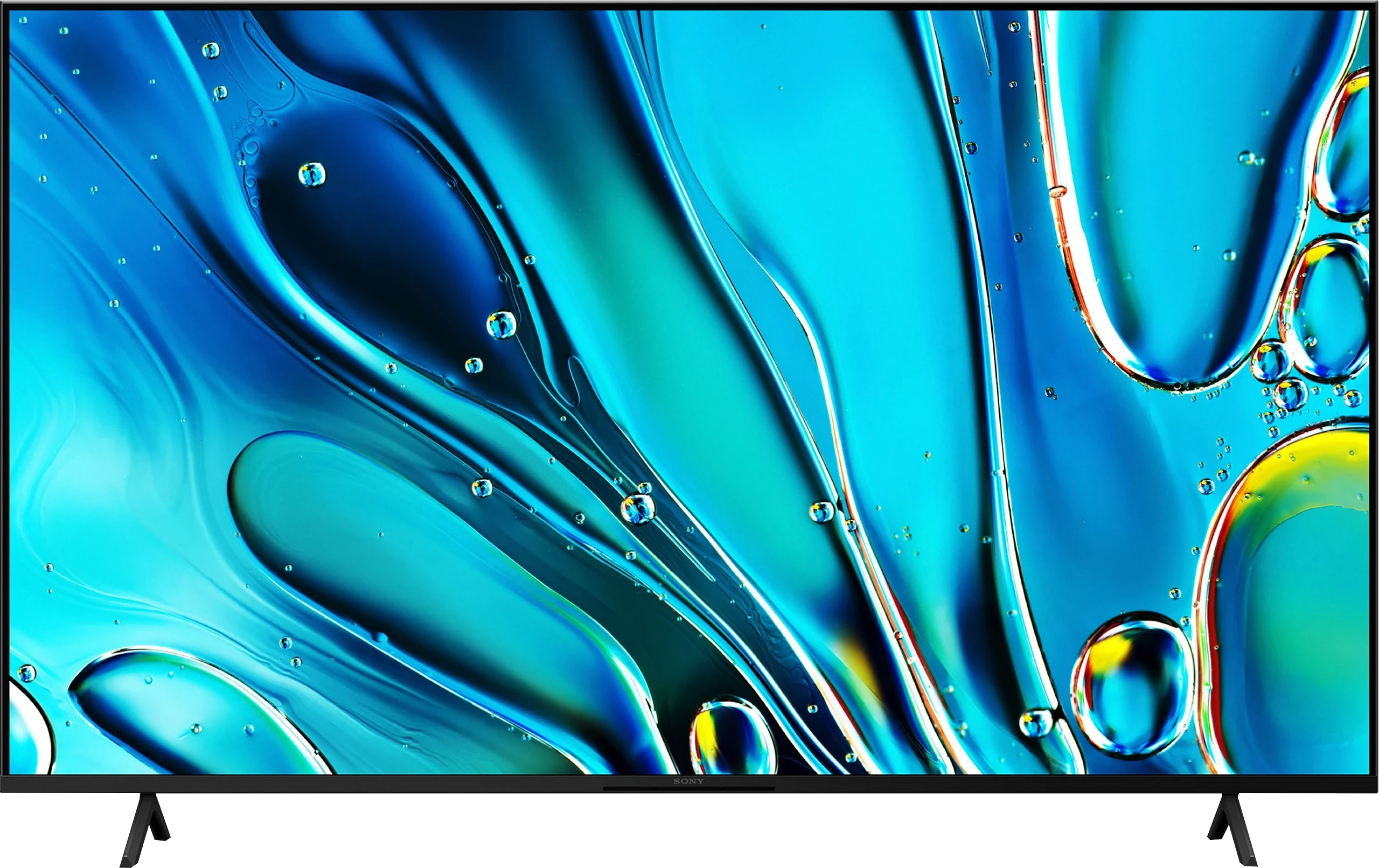
Panel type: WRGB OLED
Resolution: 3840x2160
System: Tizen
Model year: 2024
Complete the survey to find out the result

Panel type: LCD IPS
Resolution: 3840x2160
System: Google TV
Model year: 2025
Complete the survey to find out the result

Overall rating
7.8
6.0
Movies and series in UHD quality
7.8
5.4
Classic TV, YouTube
8.6
5.3
Sports broadcasts (TV and apps)
8.4
5.7
Gaming on console
9.4
6.4
TV as a computer monitor
7.6
6.0
Watching in bright light
5.0
4.9
Utility functions
7.4
6.6
Apps
8.7
9.6
Sound quality
7.0
6.5
Complete the survey to find out what fits your preferences
Advantages
Excellent contrast - OLED
Tizen system – fast and intuitive
Solar remote – control of other devices (e.g. decoder)
Outstanding viewing angles – OLED
High motion fluidity – 120 Hz panel
Many features for gamers
Unusual design
Price
Google TV system – a vast library of apps and services
IPS panel with good viewing angles
Enhanced colours – (91% DCI-P3 colour gamut)
Supports Dolby Vision
Good upscaling – lower quality materials look surprisingly good
Excellent input lag and ALLM mode
Very good PC compatibility – supports 4:4:4 chroma, excellent font readability
Two remote controls included – modern minimalist and classic with a numeric keypad
Very good built-in media player – supports a wide range of files, even less common ones like HEIC
Thin bezels and modern design – a significant step forward compared to X75WL
Supports Dolby Atmos and DTS:X
Disadvantages
No recording function from built-in tuners
Average SDR brightness – 310 nits
No support for DTS audio tracks
Tragic black - IPS matrix without local dimming
Limited brightness (approx. 350 nits), the image in HDR mode is not very appealing
Issues with backlight uniformity
The Google TV system can stutter
Lack of recording function from built-in tuners to USB memory
Our verdict
Sony Bravia 3 is a television that brings several important improvements over its predecessor, while remaining true to its core. The biggest change is the design – slim bezels and sturdy metal legs give it a modern appearance that fits much better in a living room than the X75WL. Improved colours thanks to the PFS filter and really good upscaling should also be noted. It is particularly in lower quality content, especially in classic SDR, that the Bravia 3 shows its best side – colours look pleasing, the image is clear, and thanks to the IPS panel, viewing angles are at a very good level. It is perfectly suited for the role of a “classic” television receiver, where the convenience of watching from different spots in the room and decent quality of everyday content matter. A huge advantage remains the Google TV system. During our tests, there were times when the interface did not always work as smoothly as we would have liked, and some features could freeze. However, despite these imperfections, the presence of Google TV is a significant plus – access to thousands of applications and a full streaming library compensates for minor shortcomings. Unfortunately, what was weak in the X75WL remains weak here as well. The IPS panel has very low contrast and does not offer local dimming, making watching films in a dark room quickly lose its appeal – black resembles grey and effectively detracts from the enjoyment of the viewing experience. Additionally, the option to record content to USB, which was available in its predecessor, has been dropped. It is hard not to notice this and not add it to the list of downsides.
So who is the Bravia 3 for? Primarily for those looking to enter the world of Sony televisions at a potentially low price and who also appreciate the Google TV system. However, it is not the most attractive option in its class – competitors in this budget can offer models with Mini-LED backlighting, whose images perform several times better in terms of contrast and HDR. Therefore, the Bravia 3 is worth keeping in mind, but mainly when a solid discount is available. At regular price, it will be very difficult to stand out against its more cost-effective rivals.
TV appearance







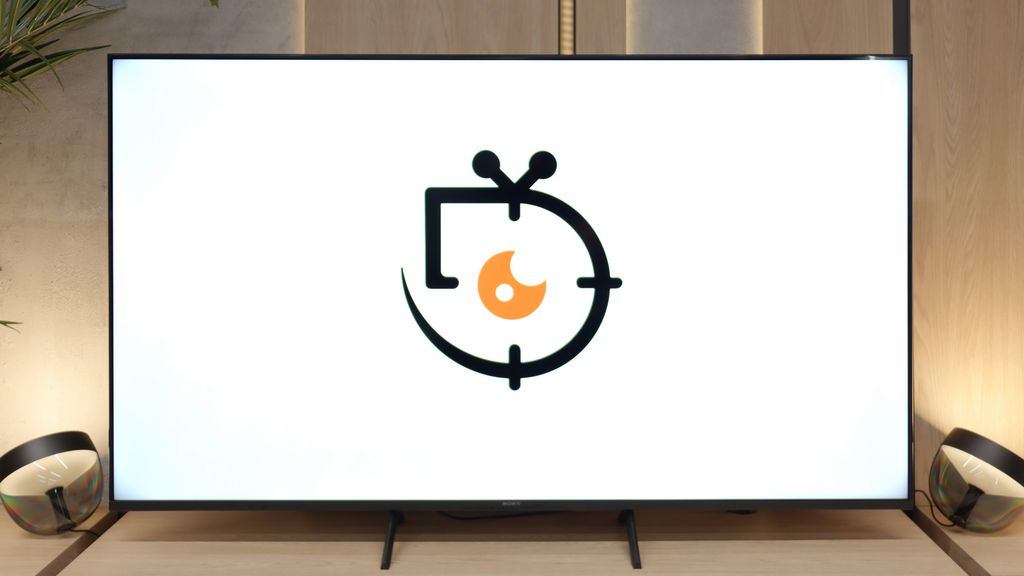
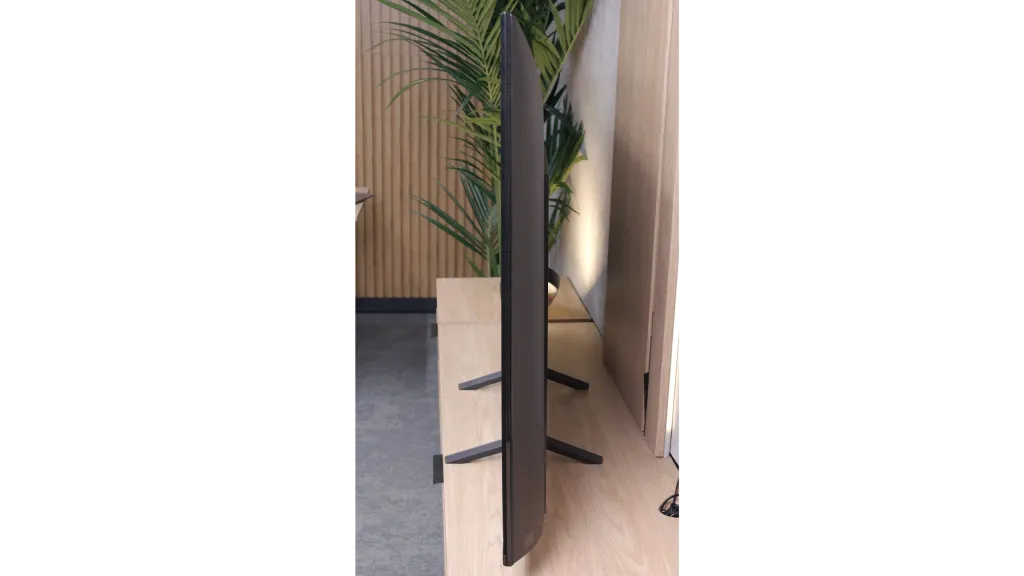
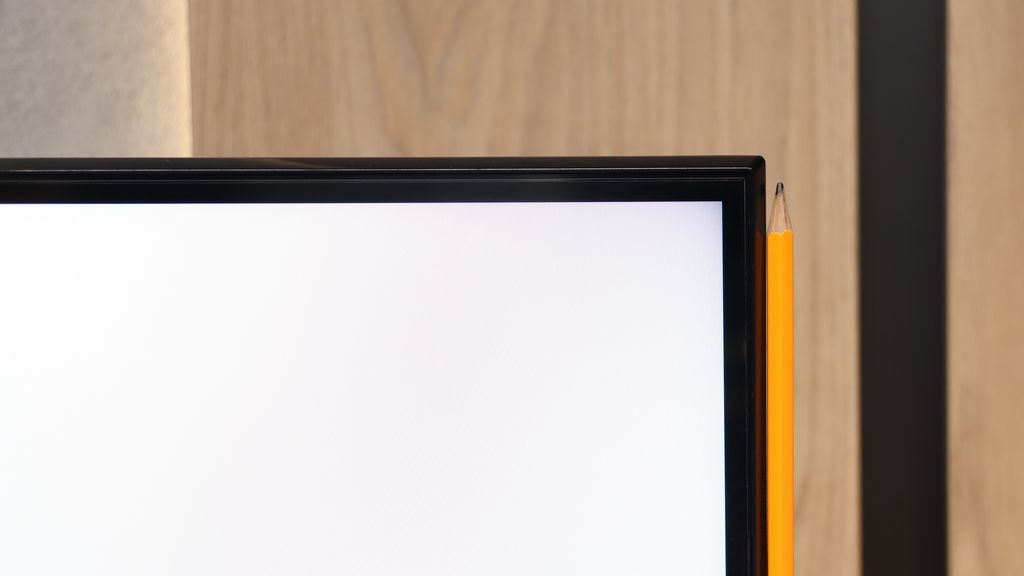
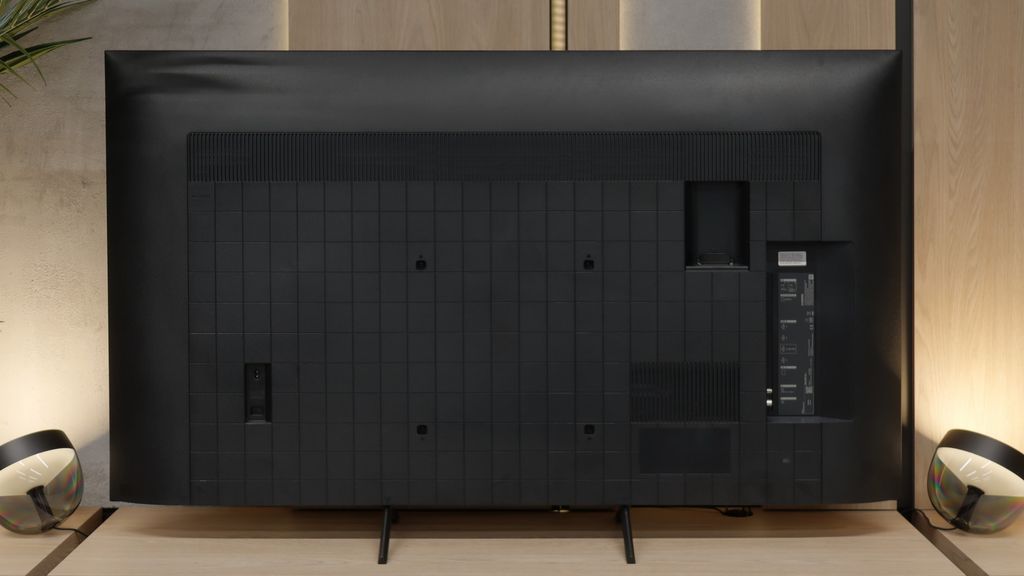
Contrast and black detail
10/10
2.2/10
Local dimming function: No
Contrast:

Result
∞:1

Result
∞:1

Result
∞:1

Result
∞:1

Result
∞:1

Result
1,150:1

Result
1,150:1

Result
1,050:1

Result
1,050:1

Result
900:1
Halo effect and black detail visibility:

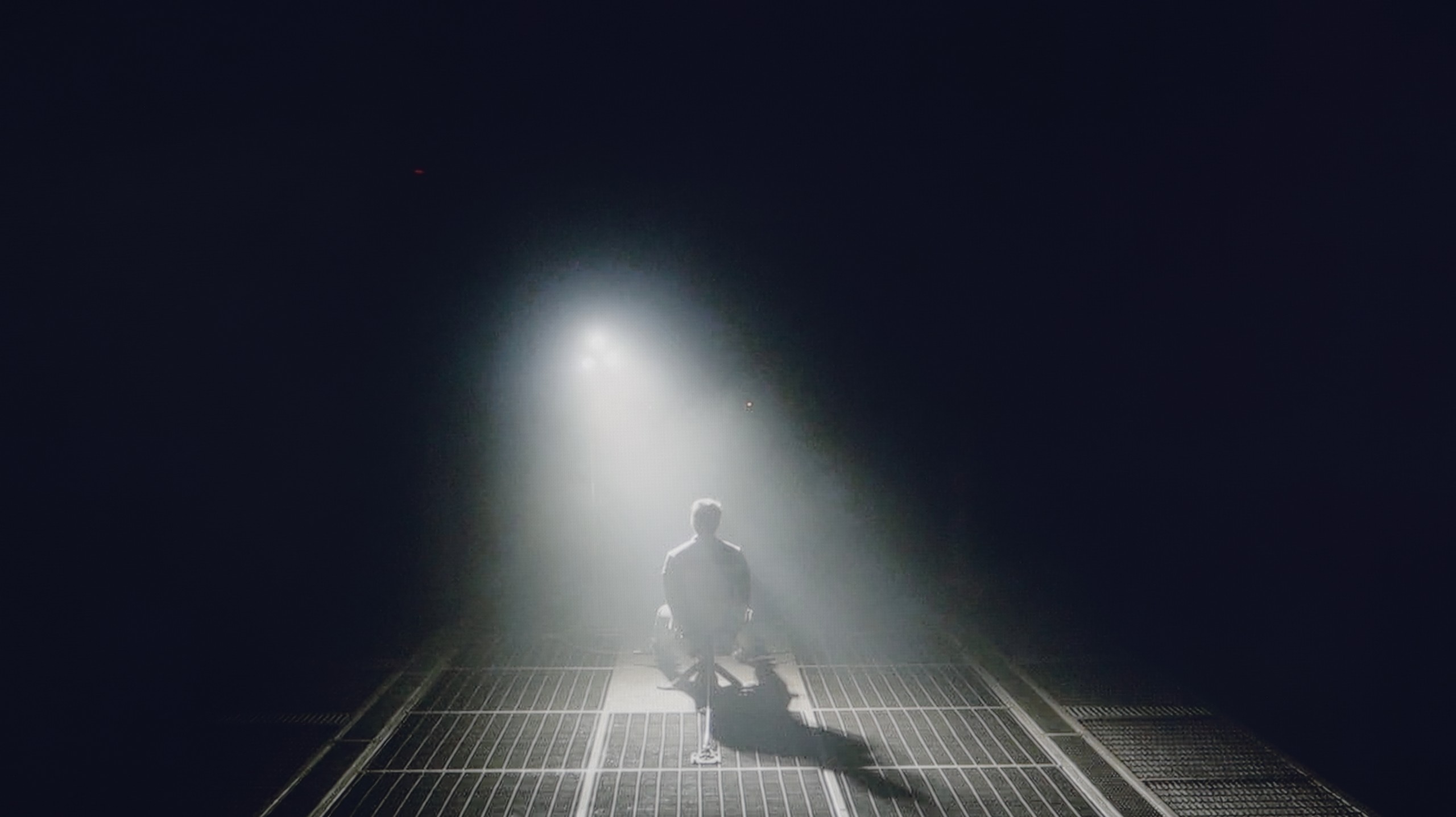
Samsung S85D is a television that truly makes a difference when it comes to picture quality. The black is so deep it's hard to believe, and the contrast ensures that even the most demanding scenes – like those from the film "Oblivion" – look incredibly realistic. Thanks to OLED technology, the dark areas of the screen are perfectly black, without any unnecessary glow or overexposure.
It's worth noting that, similar to some variants of the S90D model, the Samsung S85D uses a WOLED panel supplied by LG. This panel is a key element that contributes to the amazing quality of contrast, which is particularly noticeable in scenes with a high dynamic range of light, making it an ideal choice for fans of films and series with high production quality.
The Bravia 3 in most variants, including the 65-inch model we tested, uses an IPS panel and unfortunately, this is not the best news for those who value depth of image and true velvety blacks. This technology has its advantages, as it offers decent viewing angles, but these come at the cost of very low contrast, which is particularly noticeable during evening viewings when we expect the screen to go dark where it should. However, this is not the end of the list of problems. Our unit also exhibited noticeable unevenness in blacks, which exacerbates the effect of their shallowness. For example, in a scene with a helicopter, the blooming in the corners of the screen and pronounced vignetting are clearly visible.
It's hard not to think that even a simple local dimming system could have salvaged the situation and added a touch of drama to the image, which is lacking here. Unfortunately, Sony has decided against such a solution, and as a result, we have a repeat of last year's issues. The Bravia 3 is therefore not a television that will charm you with cinema-like black depth. At night, instead of intense blacks, we are likely to see a grey pretending to be darkness, which may disappoint more demanding viewers.
HDR effect quality
5.7/10
4.6/10
Luminance measurements in HDR:

Result
570 nit

Result
580 nit

Result
666 nit

Result
629 nit

Result
283 nit

Result
316 nit

Result
327 nit

Result
369 nit

Result
236 nit

Result
379 nit
Scene from the movie “Pan” (about 2800 nits)


Scene from the movie “Billy Lynn” (about 1100 nits)


Static HDR10


Dynamic: HDR10+
Dynamic: Dolby Vision


HDR luminance chart:
SONY BRAVIA 3
HDR luminance
Samsung S85D
HDR luminance
Luminance of RGB colors
Brightness is a key parameter in televisions, and the S85D Samsung model offers levels comparable to other OLEDs from a few years ago. Although it does not impress in this regard, its enormous advantage is the very competitive price. A peak brightness of 600 nits ensures good image quality in HDR conditions, giving users a taste of cinematic experiences in the comfort of their home. However, as with many budget OLED models, the biggest issue is very bright, full-screen scenes – in such moments, like the final scene from the film “The Meg,” the television can lose even half of its brightness, which is noticeable compared to more expensive OLED models. Despite this, the television offers impressive coverage of the DCI-P3 colour palette at 99%, allowing for vibrant and accurate colours to be displayed.
Bravia 3 does not hide the fact that it belongs to the group of televisions that are rather modest in terms of brightness. Our measurements showed around 370 nits, which is a value teetering on the edge of where one can still speak of any HDR effect. For some, this is an acceptable level, while for others it is rather typical for SDR content, where spectacular highlights or vivid contrasts are not expected. The impression is that this is not a television for those focused on the highest image quality in demanding cinematic content. However, this does not mean that we cannot find any advantages here. Compared to its predecessor, the X75WL, Bravia 3 has gained an additional PFS filter, which works similarly to solutions known from QLED technology. Thanks to this, the DCI-P3 colour palette has been significantly widened and reaches over 91 percent, which in practice results in more saturated colours and a more pleasing image texture. As a result, even everyday content looks somewhat livelier, and films and series can surprise with vibrant visuals, despite limitations in brightness itself.
Factory color reproduction
6.6/10
5.8/10


Factory Mode
After calibration


Factory Mode
After calibration
The Filmmaker mode on the Samsung S85D does offer quite good factory settings, but it is not free from errors, particularly evident in colour reproduction. The white balance chart for HD and HDR content shows clear issues – both red and blue colours are significantly weakened, leading to a dominance of green. The result is an unnatural yellowish hue that can affect the perception of realistic scenes. The Color Checker test clearly shows that the colour samples deviate from expected values – for HD material, the colours can be overly saturated, with a noticeable shift towards green, which is also evident in the white balance chart. Conversely, for 4K HDR content, the colours appear too dull, lacking depth, making the image less appealing and natural. This effect is particularly noticeable in delicate scenes where colour precision plays a key role, which can be disappointing for discerning viewers who expect faithful reproduction of details and colour intensity.
As for brightness, the gamma chart for HD content looks quite good; however, there is a noticeable jump at the end, exceeding a value of 2.4. While this is not a major issue in most scenes, in more demanding sequences it may affect the clarity of bright details. For 4K content, the EOTF curve, responsible for delivering brightness, turns out to be problematic. The initial part of the chart shows a small jump. This phenomenon can result in excessive boosting of brightness in the brightest areas of the image, leading to loss of detail in very bright scenes.
Although Samsung S85D offers quite decent factory settings, especially in Filmmaker mode, it is worth considering manual adjustment of settings to improve some imperfections, particularly in colour reproduction.
Sony Bravia 3 was primarily tested in film mode, which immediately proved to be the best choice among the factory settings. It is not a perfect picture, but compared to the eco mode that the television offers right out of the box, the difference is clear and positive. In film mode, one can notice a certain problem: the image appears too warm, which results from a lack of blue colour in the white balance. Despite this, in SDR content, the final effect can still be considered quite decent and satisfactory for everyday viewing. Much more serious errors occur in HDR materials. The Color Checker analysis showed considerable deviations, and poor brightness management, combined with limited colour gamut coverage, further exposes the shortcomings of the image in this mode. All of this makes HDR on the Bravia 3 appear unconvincing and can spoil the impression left by the quite decent SDR content setting. Fortunately, this is not an insurmountable situation. Various errors can be somewhat mitigated, and some can even be fully corrected through professional calibration. Therefore, we decided to check how the television would perform after such adjustments.
Color reproduction after calibration
8.7/10
7.5/10




After calibration, the Filmmaker mode on the Samsung S85D truly impressed. The white balance, regardless of the type of content, has significantly improved, resulting in more natural colours. The Color Checker test shows that colour reproduction errors are now minimal and rarely exceed acceptable values, which indicates accurate colour rendering. The factory colour reproduction left much to be desired, but the situation has now significantly improved – the colours are natural, precise, and look as if they were rendered exactly according to the creators' intentions. This is a huge step forward compared to previous generations, where colours were often distorted or too intense.
The brightness characteristics also benefited from the calibration – it is now more vivid and precise. The gamma, although fairly good previously, has become even more stable, providing a deeper, more natural image. The EOTF curve has been aligned, allowing details in dark areas to be more visible and the contrast more balanced. With all these improvements, the television delivers an image close to reference quality, greatly enhancing the enjoyment of watching films and HDR content.
The calibration allowed us to extract significantly more from the Bravia 3 than we could have expected at the beginning. Firstly, it managed to compensate for the deficiency of blue, which had previously caused a noticeable warming of the image. After a slight adjustment to the white balance, most of the errors in the Color Checker measurements for SDR content virtually disappeared. The white tones became more natural, and the brightness management in gamma stabilised to an almost ideal level, not exceeding the threshold of human perception. Thus, it can be confidently stated that in SDR content, after a few adjustments to the settings, the Bravia 3 performs remarkably well. Significantly worse, although still definitely better than before calibration, are HDR contents. The white balance was brought into order, however, the limitations of the IPS panel are insurmountable. The lack of local dimming means that even the smallest elements can be overexposed, which immediately stands out. Colour-wise, the effect is also improved, though far from perfect – many errors still exceed the threshold of four or even five delta E units, meaning they remain visible to the human eye. It was already clear earlier that the Bravia 3 is not a television designed to impress with HDR quality. Nevertheless, it is gratifying that in SDR content, after calibration, the image can look truly excellent, and in this category, the television pleasantly surprised us.
Smoothness of tonal transitions
7.2/10
8/10












Samsung OLED S85D performs very well with the smoothness of tonal transitions. There are no major issues, and the transitions between different colour levels are smooth and natural. The only minor drawback is slight issues around the reds, where in some scenes, subtle disturbances can be noticed. Nevertheless, the overall effect is very positive – the television handles most materials excellently.
In terms of the fluidity of tonal transitions, the Bravia 3 performs really well. In brighter scenes, we did not notice any significant errors – the screen handles the blending of colours almost flawlessly and does not create artificial contours that can spoil the viewing experience. Similarly, in darker segments, there are no major issues with colour gradation, although another problem arises here. Strong brightening and uneven backlighting of the panel in dark scenes make it difficult to assess the gradation itself clearly, as the effect is spoiled by the unevenness of the image. However, when we focus solely on the blending of colours, the result should be considered very good.
Image scaling and smoothness of tonal transitions
7.4/10
7/10
Smooth transition function


Image without overscan on the SD signal


Samsung S85D performs excellently in scaling images and smoothing tonal transitions. Like in other Samsung models, the television offers three noise reduction modes: off, standard, and high. Although it effectively improves gradations, it unfortunately also removes film grain, which many viewers desire to give the image a cinematic character. This grain often adds authenticity and a certain rawness to films, which is lost after smoothing. Removing the grain can make the image look too sterile and smooth, which detracts from the charm of the original film material. When it comes to scaling images, the Samsung S85D handles lower resolution content beautifully – the model in the picture and the branches in the background were displayed correctly, with no major issues with edge aliasing. The only noticeable drawback is the presence of overscan, which can sometimes cut off parts of the image, which may not please everyone.
Bravia 3 brings something more to the Sony TV family than just a shared name. It stands out primarily for its ability to enhance the quality of weaker materials thanks to the processor used. Of course, we won’t find the advanced XR chip known from more expensive models here, but even so, it must be admitted that the image in lower resolutions looked surprisingly good. The scaling worked effectively, and most parts of the screen were free from the typical excessive edge tearing found in budget constructions.
Attention should also be paid to the function that improves the smoothness of tonal transitions. In the high setting, it works really well, effectively masking gradation imperfections without significant detail loss. It does happen, however, that the algorithm overly smooths elements that should remain sharp – for example, faces – but overall, the effect is beneficial. The best results were achieved precisely at the highest setting, and this option could be recommended to those watching lower quality content.
Blur and motion smoothness
8.5/10
5/10

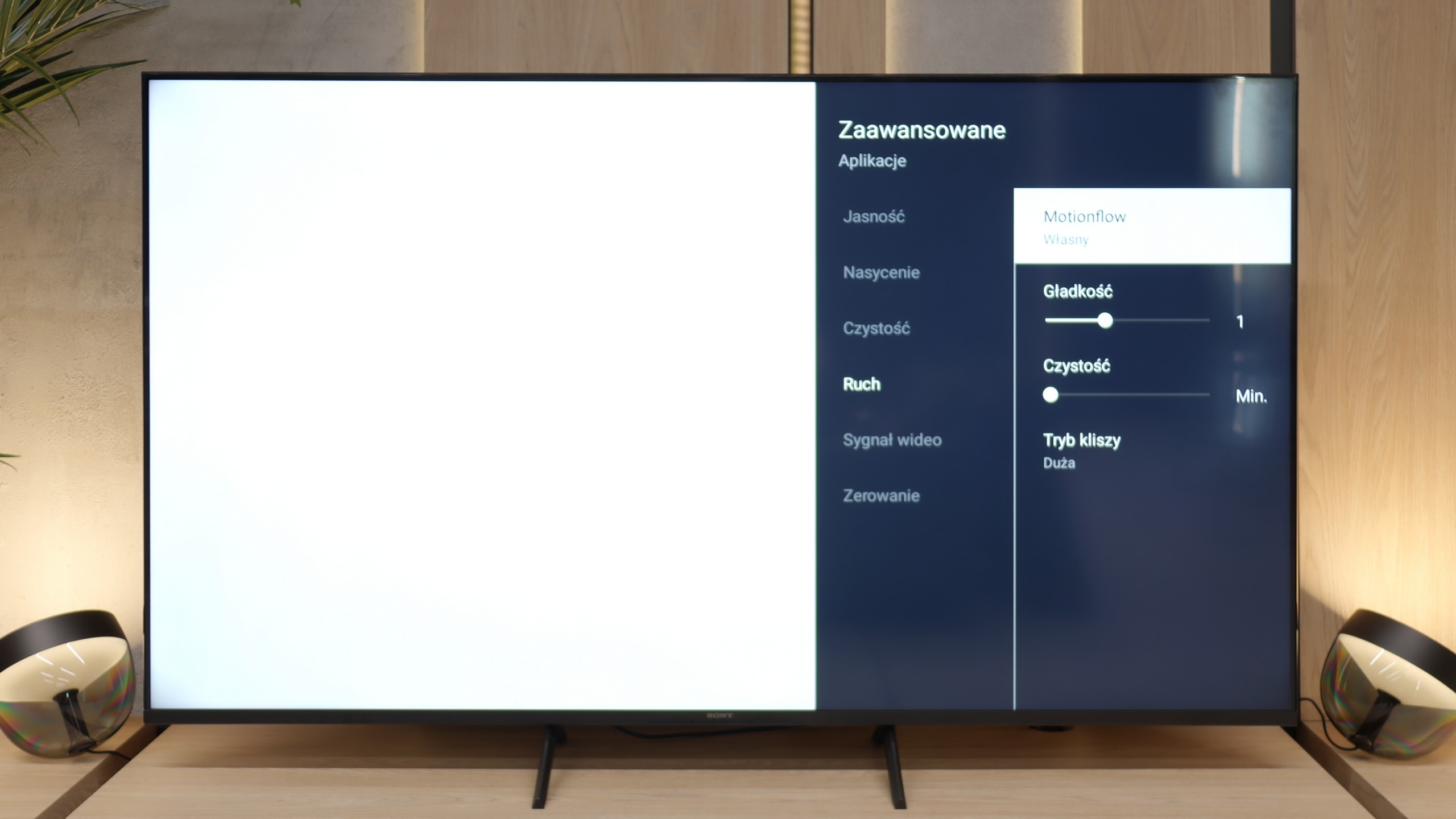
Blur (native resolution, maximum refresh rate):



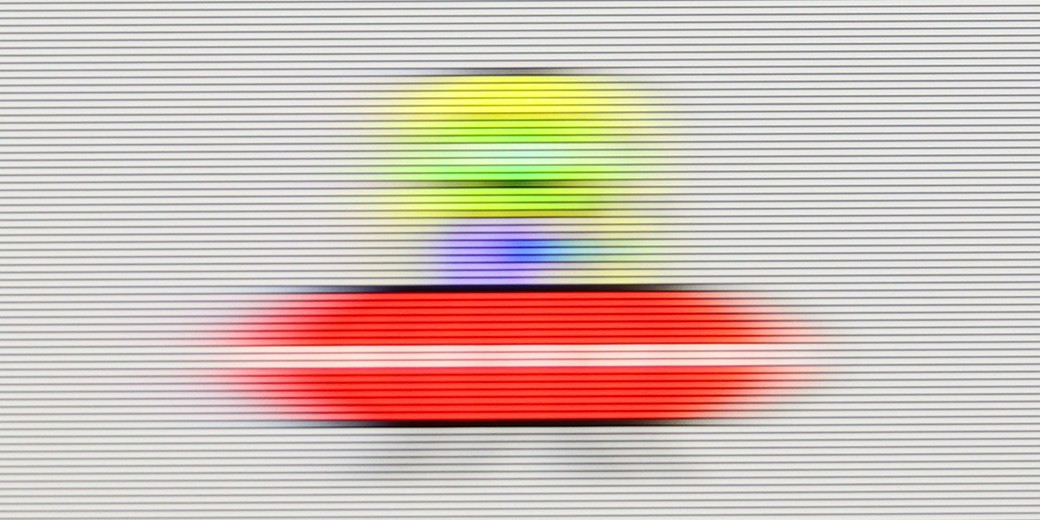
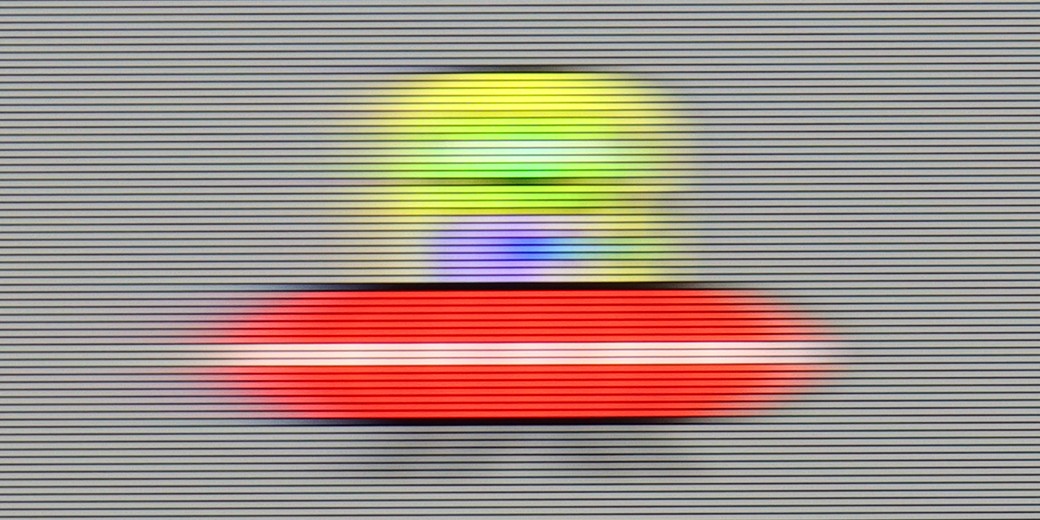
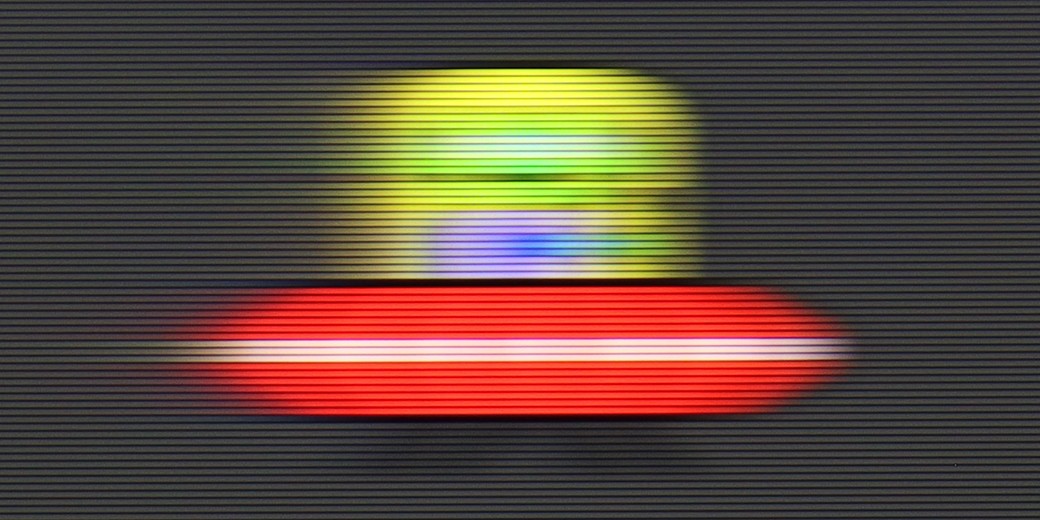
Blur (BFI function enabled):
Image flickers in this mode
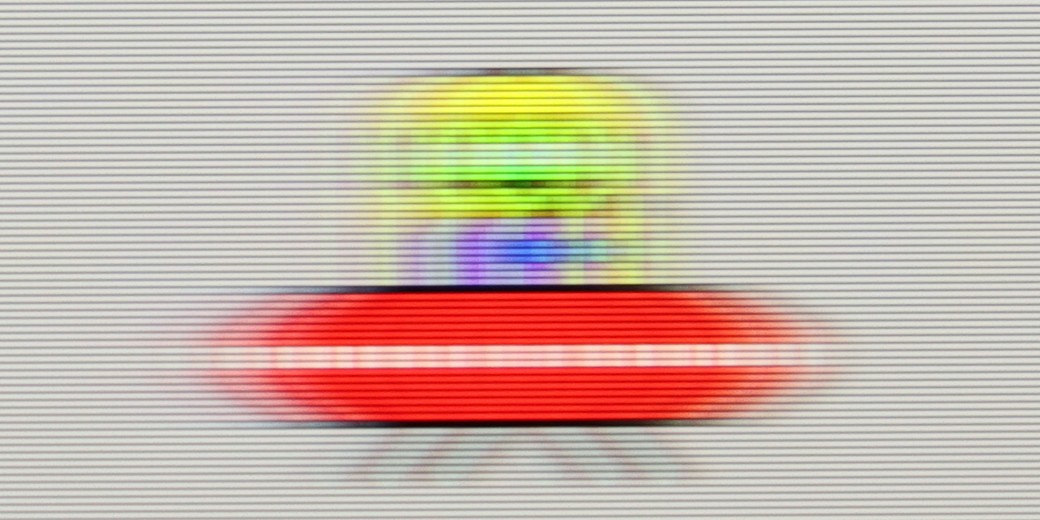
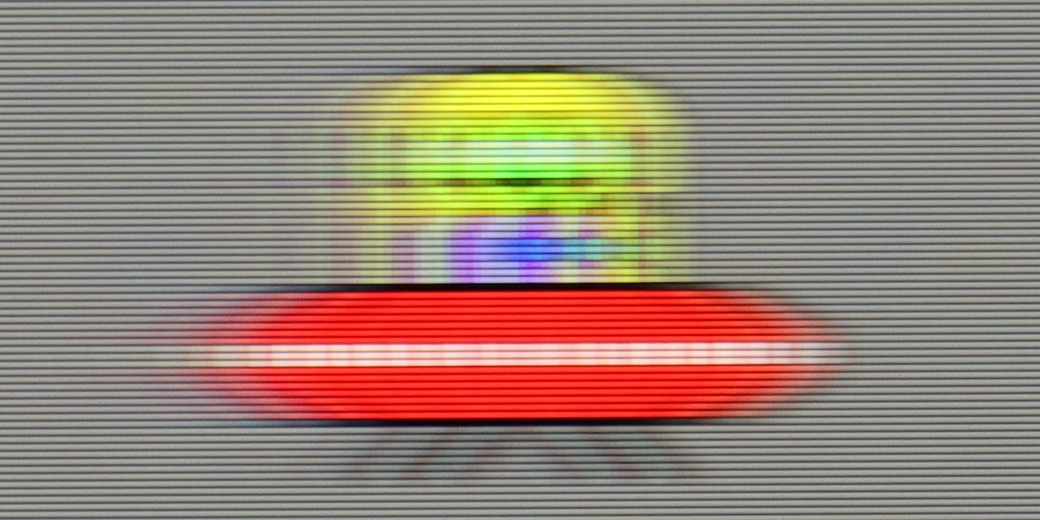
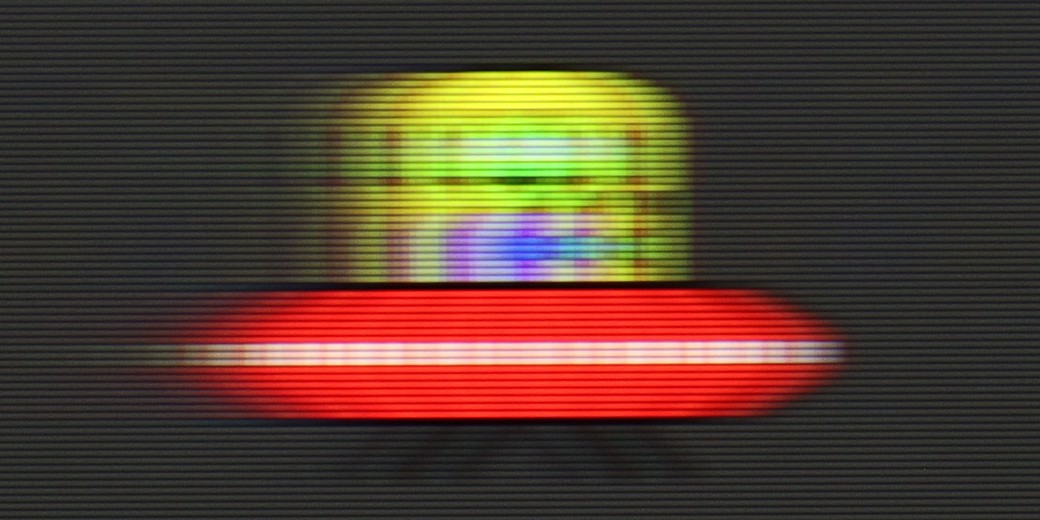
As befits an OLED television, Samsung S85D offers excellent motion fluidity. Equipped with a 120 Hz panel and fast response time, the television provides very smooth playback of dynamic scenes without visible ghosting. For movie enthusiasts, there is a feature called "Image Clarity Settings," which allows adjusting the fluidity of the image to individual preferences on a 10-point scale. Motion blur reduction enhances the sharpness of rapidly moving objects, while motion smoothing smooths out movement, eliminating the "judder" effect. This way, every user can set the appropriate level of clarity that best suits their taste, from a more cinematic effect to sharper, smoother movements.
The fluidity of motion has never been a strong point of televisions equipped with 60 Hz panels, and the Bravia 3 is no exception. Nevertheless, Sony has added something that may appeal to those more sensitive to the way images are displayed. We are talking about the proprietary motion smoother, Motion Flow, which offers users a considerable range of adjustment options. Thanks to it, one can make the image smoother, even theatrical, or stick to a more cinematic style with the characteristic judder that many simply associate with the filmic atmosphere. These functions work with content at lower frame rates, such as films and series recorded at 24 or 30 frames per second, which are the materials we encounter on a daily basis. It is here that the motion smoother proves to be one of the most important features in everyday use of the television, and this is where the Bravia 3 performs quite well.
Console compatibility and gaming features
9.5/10
4/10
- ALLM
- VRR
- VRR range48 - 120Hz
- Dolby Vision Game Mode
- Correct implementation of HGIG
- 1080p@120Hz
- 1440p@120Hz
- 4K@120Hz
- Game bar

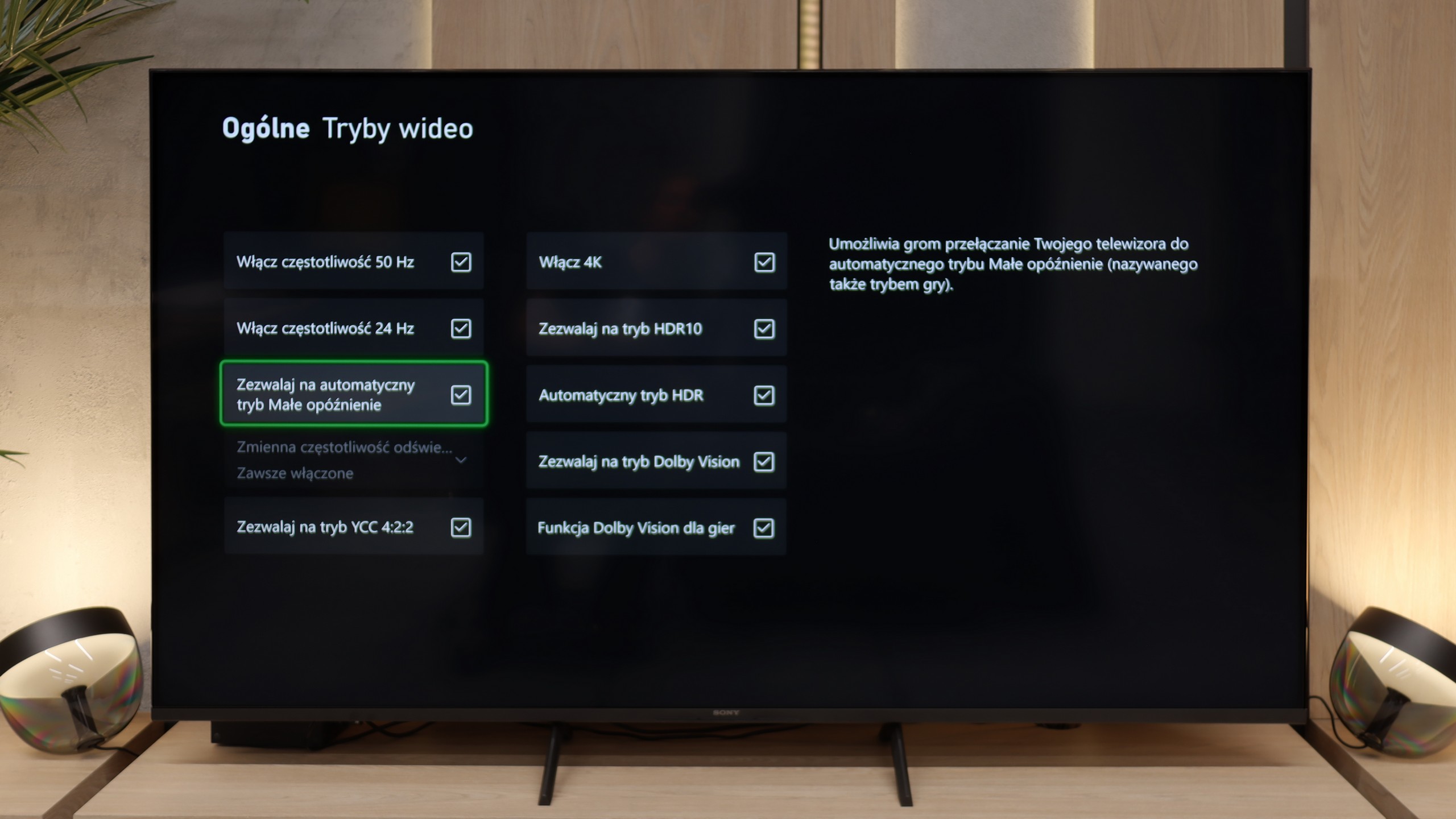

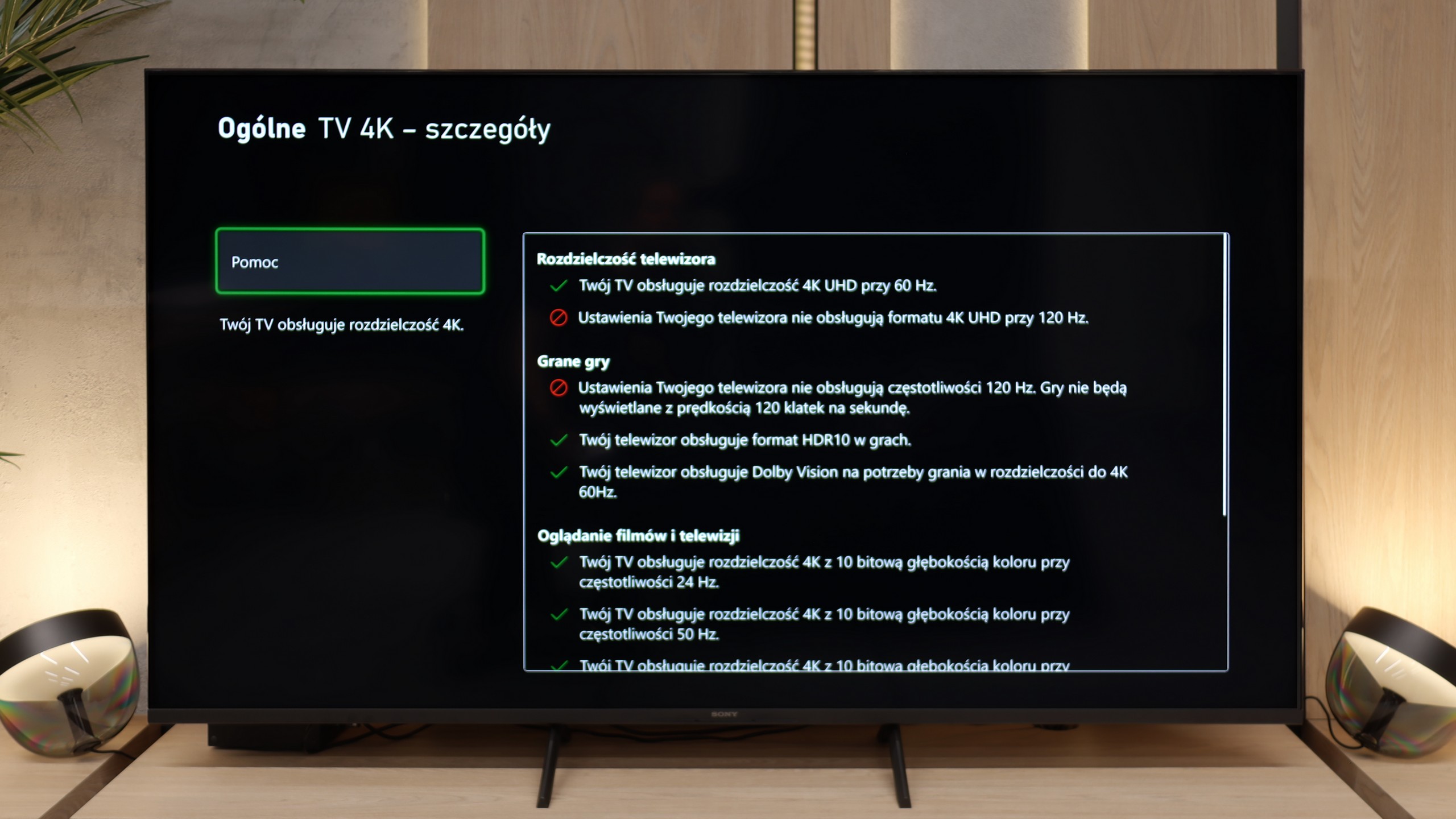

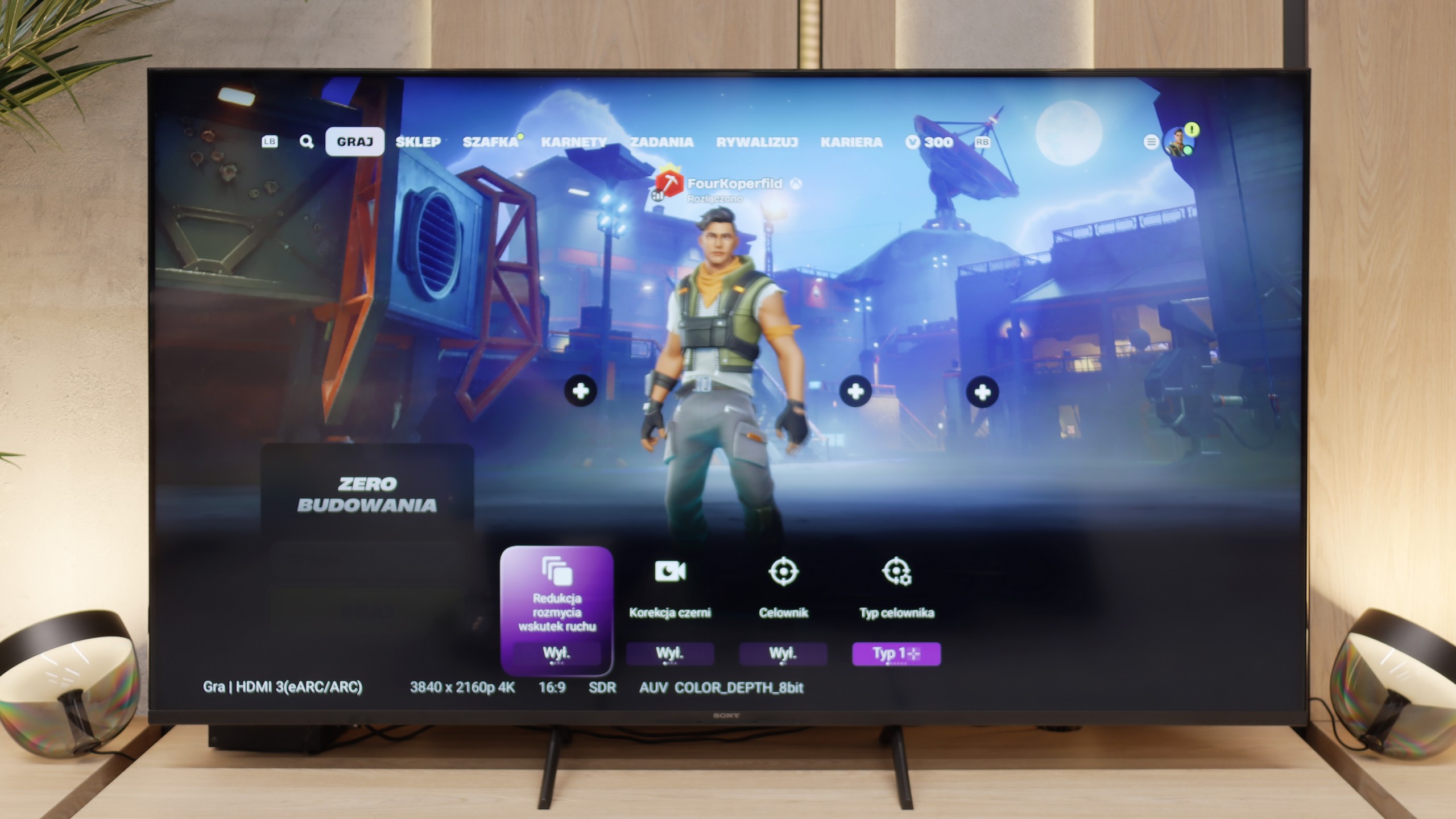

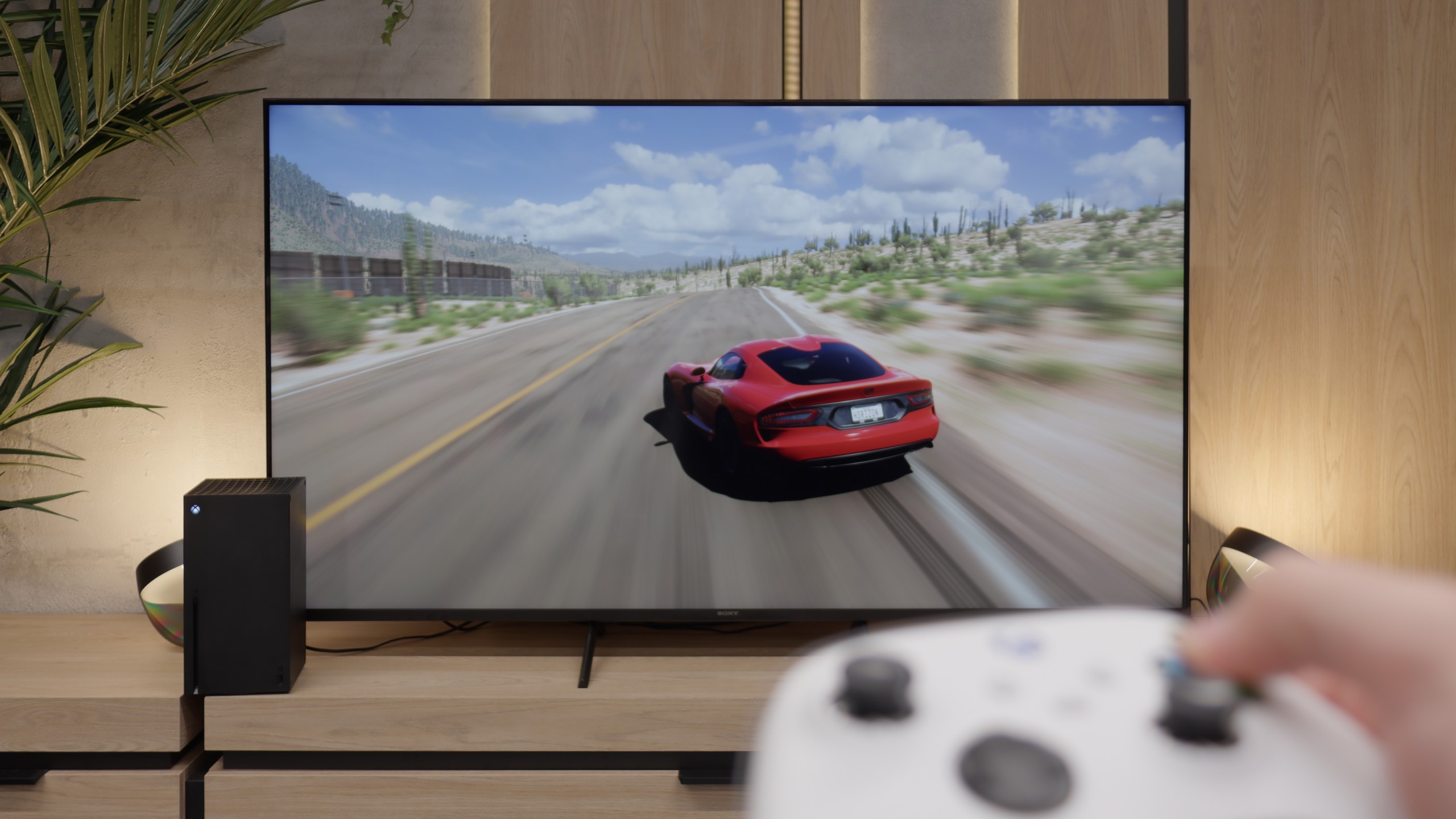
Samsung S85D OLED is an excellent choice for gamers, thanks to its many modern features that facilitate and enhance gameplay. The television has four full-bandwidth HDMI 2.1 ports, allowing you to connect the latest consoles without worrying about image quality or frame rate limitations. This means support for 4K resolution at 120 Hz, which is ideal for modern titles. Additionally, the Samsung S85D has an ALLM (Auto Low Latency Mode) feature that automatically activates low latency mode when it detects a gaming device. This means you don’t have to manually switch settings – the television takes care of ensuring a fast response time, which is crucial in games where every second counts.
The VRR (Variable Refresh Rate) feature and G-Sync support are additional elements that make gameplay smoother. VRR adjusts the refresh rate to the number of frames generated by the console or computer, eliminating screen tearing and stuttering. This is particularly useful in dynamic games where the frame rate can fluctuate. Auto Motion Plus Game is a feature that Samsung has introduced with gamers in mind, and it is worth appreciating. With it, the image in games becomes smoother – 30 frames per second look like 45, and 60 Hz gains in fluidity, creating an effect close to 90 Hz. At the same time, there is no significant increase in input lag, which remains below 25 ms, making this feature stand out among others available on the market. Gamers can enjoy a smoother image without worrying about a decline in responsiveness.
Samsung has also ensured something extra – the television has a built-in Xbox Game Pass app, which means you can play in the cloud without needing to own a console. This is a great solution for those who want to enjoy gaming without investing in additional hardware. All you need is internet access, and you have a huge library of games at your fingertips. This makes Samsung S85D a fantastic choice for both casual gamers and those who are more advanced.
Bravia 3 is not equipment for e-sports enthusiasts or fans of night marathons with a controller in hand. The lack of 120 Hz refresh rate and HDMI 2.1 ports closes the topic before it even has a chance to develop. This is a television for casual gamers who will play FIFA or racing games after work, not for someone who measures every frame in a spreadsheet. Nevertheless, Sony has added a few nice extras to ensure it’s not too sparse. ALLM works as it should, automatically switching the television to game mode (low latency). There’s even a simple Game Bar, which is clear. However, the biggest novelty here is the PlayStation Portal app. Thanks to it, you can launch PS5 games wirelessly and view them immediately on the television screen. It sounds great, but just a few minutes is enough to feel significant lag. In our opinion, it’s more of a showcase of capabilities than something that can be used every day. If someone really wants to play, it’s better to connect the console via HDMI cable and forget about wireless issues.
Input lag
9.9/10
10/10
SDR
HDR
Dolby Vision
Samsung S85D achieves excellent results in terms of input lag, regardless of the refresh rate or resolution. This means that the screen responses are almost instantaneous, which is particularly important in fast-paced, dynamic games. Gamers can count on the television's lightning-fast response to controller movements, providing an advantage in competition and greater satisfaction from gameplay. Low input lag is a definite advantage of this model, making the Samsung S85D OLED the perfect choice for gaming enthusiasts.
Here, the Bravia 3 shows its best side. Latencies drop below 12 milliseconds in almost every resolution and mode, so the response to controller movements is instantaneous and there is no feeling of delay. It feels as though the console and the television are speaking the same language, without unnecessary pauses or hesitations. The Dolby Vision Gaming mode is particularly noteworthy. In its predecessor, the X75WL model, using this feature was simply a pain – input lag could exceed 100 milliseconds, which effectively spoiled the enjoyment of gaming. In the Bravia 3, this issue has been completely eliminated.
Compatibility with PC
7.6/10
6/10

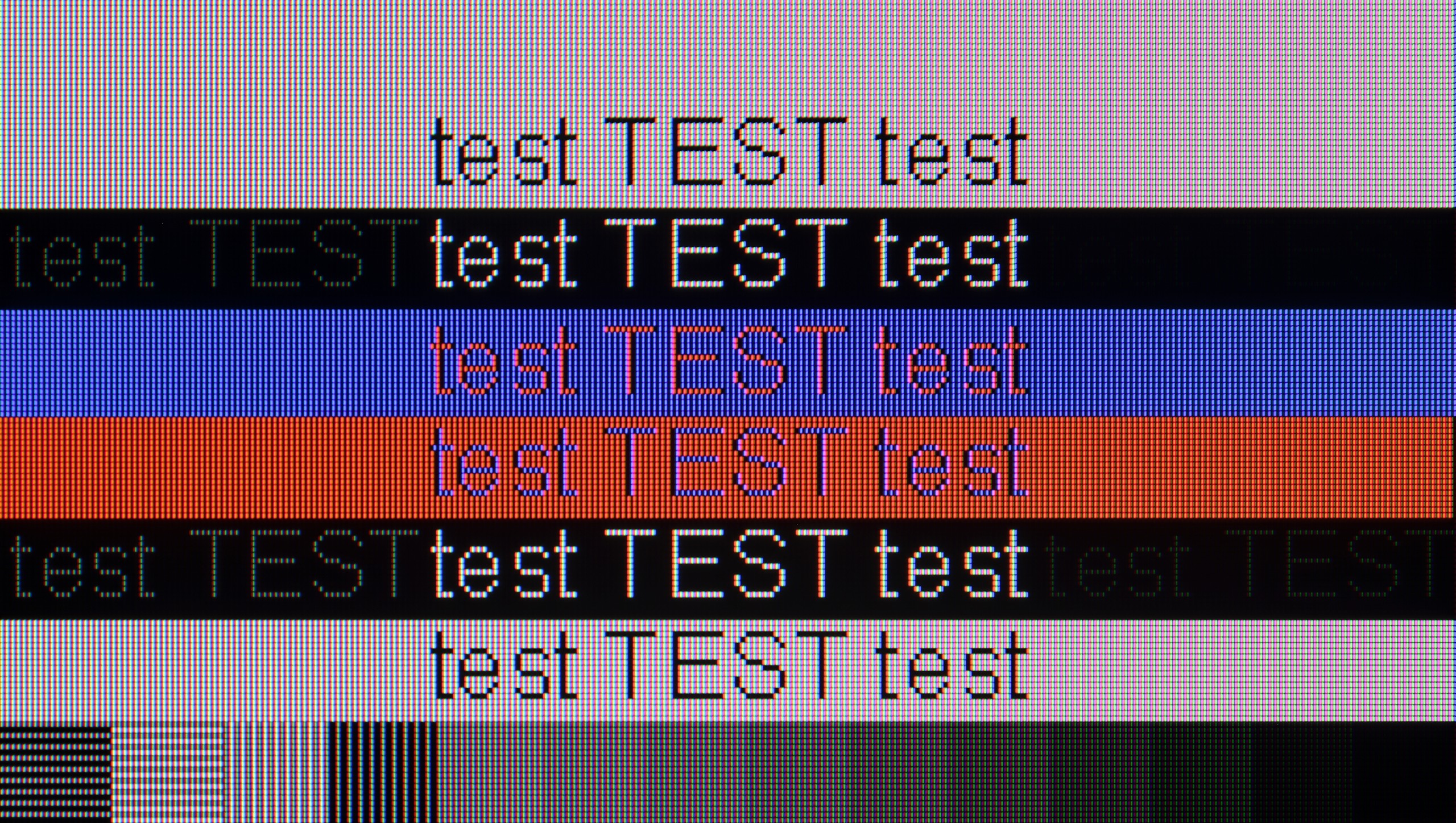
Samsung S85D performs very well as a computer monitor. Thanks to the clear visibility of text, regardless of the type of background, using it is convenient and comfortable. The support for 4:4:4 chroma ensures precise rendering of text and graphics, which is important for office work, browsing the internet, or editing documents. Samsung S85D is a versatile television that also easily serves as a monitor for everyday use. We deducted 0.4 points for the WRGB layout, as is the case with any television with such a sub-pixel arrangement.
The applied IPS matrix, combined with properly functioning support for chroma 4:4:4, ensures that the readability of fonts is at an excellent level. Letters appear sharp, regardless of the background colour or the content itself, so working with documents or browsing websites does not strain the eyes. In this role, the television easily deserves a very good, if not outstanding, rating, as there are not many models in this budget that perform as well. Of course, if we look at the Bravia 3 from a PC gamer’s perspective, the picture is not quite so rosy. We won't find G-SYNC or Free Sync frame synchronization with graphics cards, nor high refresh rates, so the television is not the best choice for fast-paced computer games. However, it performs excellently as a monitor for work, whether in a home office or a student room, and in this respect, it is truly hard to criticise.
Viewing angles
7.7/10
6.6/10
The viewing angles on the Samsung S85D are excellent, as is fitting for an OLED. The image remains sharp and does not lose quality even when viewed from a wide angle, making the television perfect for larger rooms and watching together with family or friends. The only televisions that offer better viewing angles are those with QD-OLED or MLA OLED panels.
Thanks to the use of an IPS matrix, colours do not lose intensity as quickly as in the case of screens based on VA panels. Even when watching television with a larger group, when some people sit at an angle, the image remains clear and does not appear washed out. Of course, it is not at the level offered by organic OLED matrices, where the image looks identical from almost any position, but for an LCD television, the viewing angles in the Bravia 3 are among the better ones. This provides a sense of comfort and freedom, especially in larger living rooms or during family viewings, where it is difficult for everyone to find a spot directly in front of the screen.
TV efficiency during daytime
5/10
4.9/10

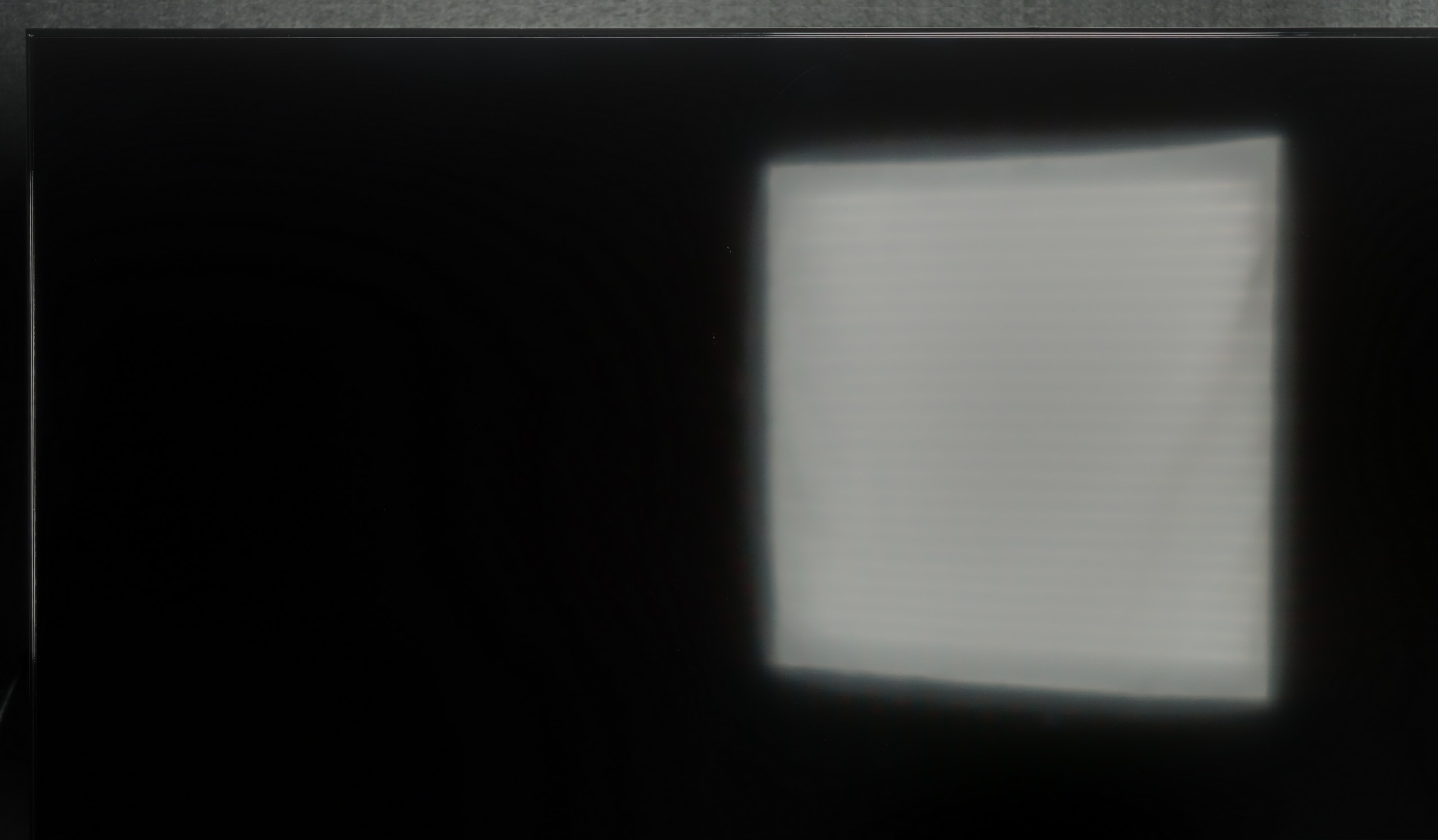

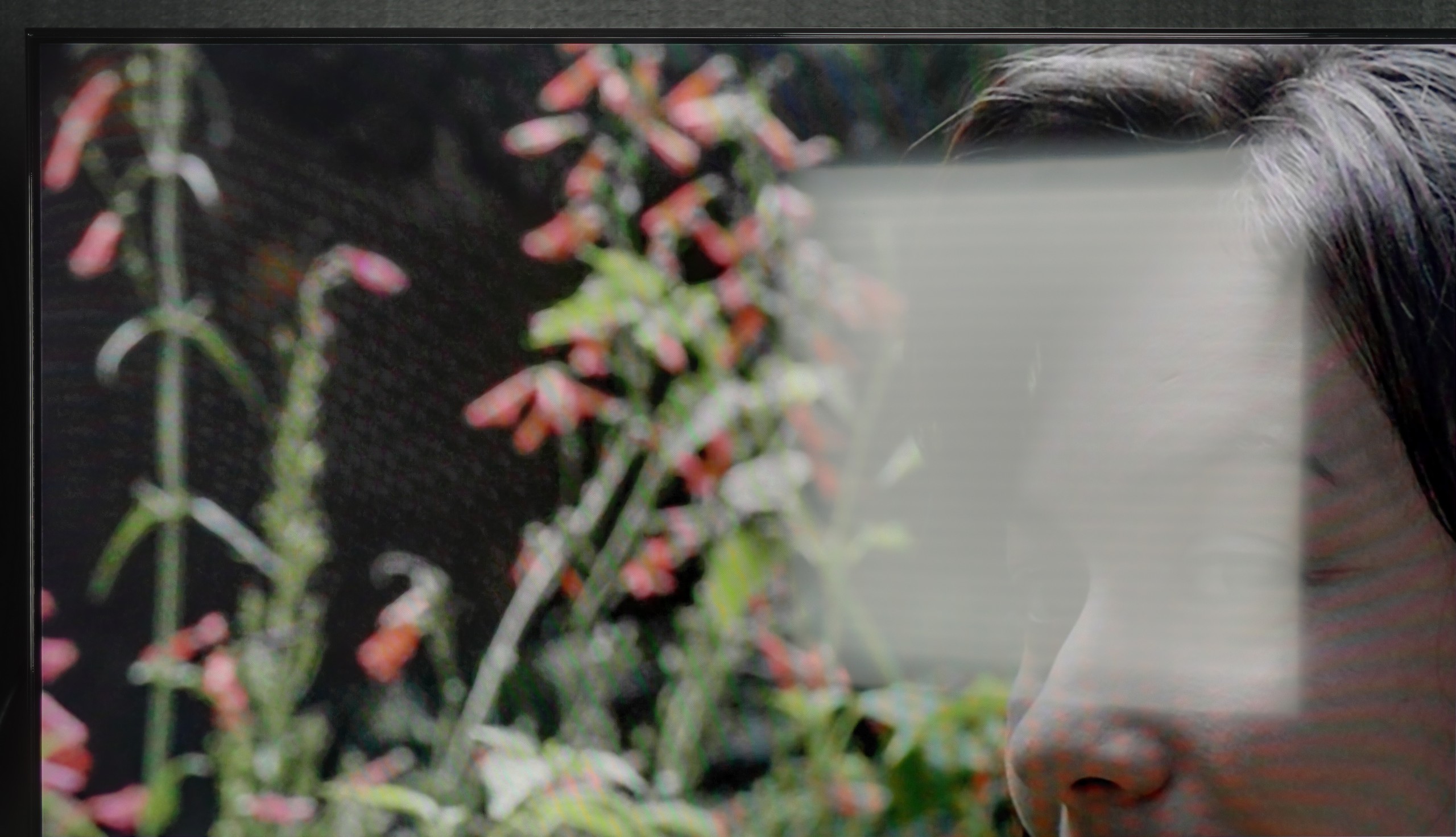
Matrix brightness
Average luminance SDR
SONY BRAVIA 3: 337 cd/m2
Samsung S85D: 313 cd/m2
Samsung S85D handles reflections quite well thanks to the satin finish of the panel, which effectively dampens them. Unfortunately, the SDR brightness of 310 nits is rather average, meaning that in very bright rooms, the TV's performance may be limited. This is not an impressive result, so this model will definitely perform better during evening viewing, when such brightness will be sufficient. During the day, to achieve better comfort, it may be necessary to draw the blinds or curtains.
Bravia 3 performs quite decently in the face of daylight. The satin coating on the panel effectively reduces reflections, and the colours do not lose their intensity when stronger external light hits the screen. As a result, in typical home conditions, with blinds open or in a living room with a larger window, the image maintains its clarity. However, it must be remembered that this is not a high-brightness television. Bravia 3 has no chance of competing with brighter models, so in very sunny rooms, there are moments when the screen simply does not stand out against intense light. In normal conditions, it will cope without problems, but in more challenging scenarios, one should not expect miracles.
Details about the matrix
Subpixel Structure:

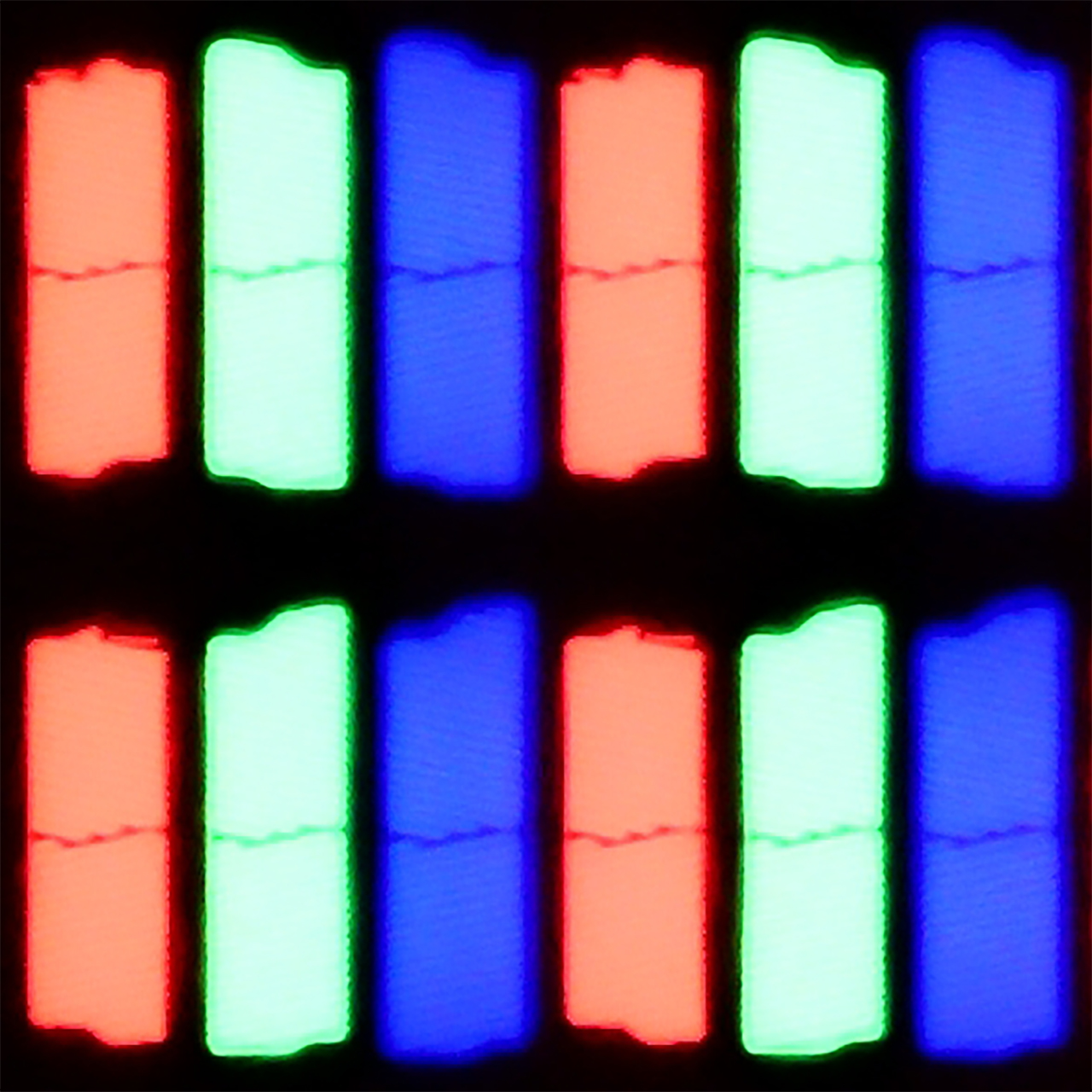
Panel uniformity and thermal imaging:

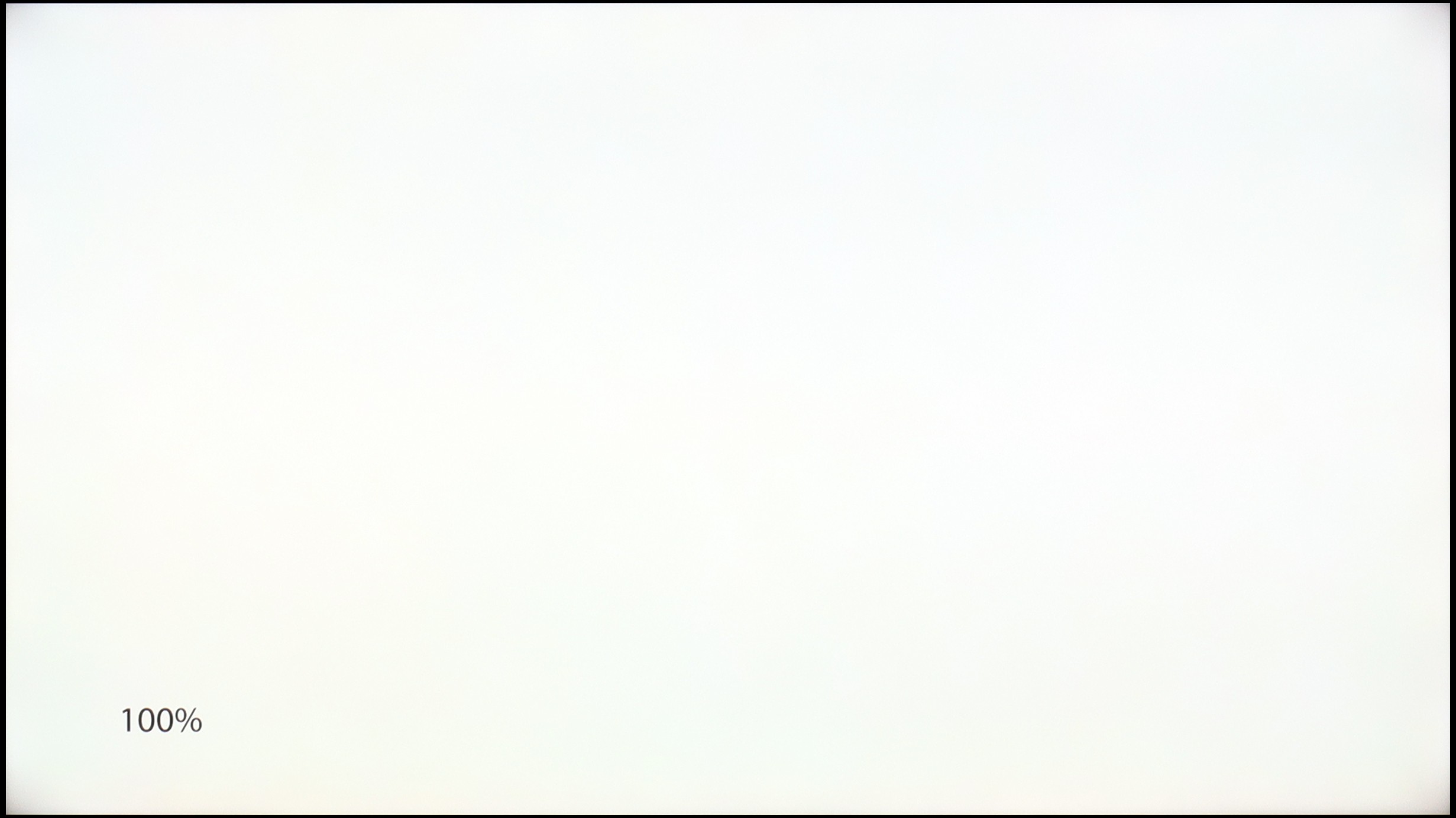
Samsung S85D
SONY BRAVIA 3
TV features
7.4/10
6.6/10
- HDMI inputs0 x HDMI 2.0, 4 x HDMI 2.1 48Gbps4 x HDMI 2.0, 0 x HDMI 2.1
- OutputsToslink (Optical audio), eARC (HDMI), ARC (HDMI)Toslink (Optical audio), eARC (HDMI), ARC (HDMI)
- Network InterfacesWi-Fi 2.4GHz, Wi-Fi 5GHz, Ethernet (LAN) 100MbpsWi-Fi 2.4GHz, Wi-Fi 5GHz, Ethernet (LAN) 100Mbps
- TV receptionDVB-T, DVB-T2, DVB-S, DVB-S2, DVB-CDVB-T, DVB-T2, DVB-S, DVB-S2, DVB-C
Classic features:
- Recording to USB (terrestrial TV)
- Recording programming
- Picture in Picture (PiP)
- RF remote control (no need to aim at the screen)
- Backlit remote control
- Teletext
- Audio only mode
- Bluetooth headphones support
- Simultaneous Bluetooth headphones & TV audio
Smart features:
- AirPlay
- Screen mirroring (Windows Miracast)
- Voice search
- Voice search in native language
- Ability to connect a keyboard and mouse


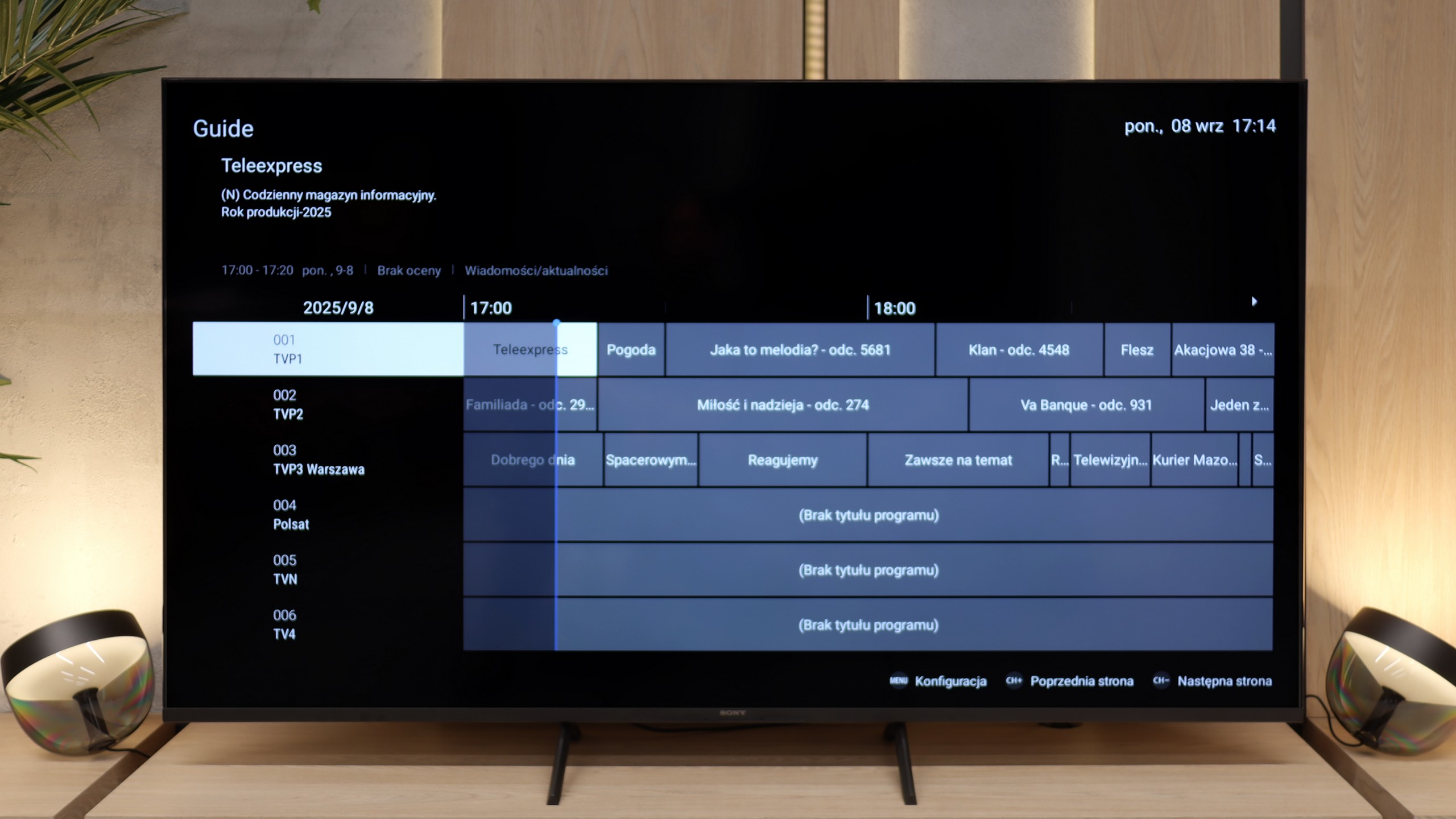
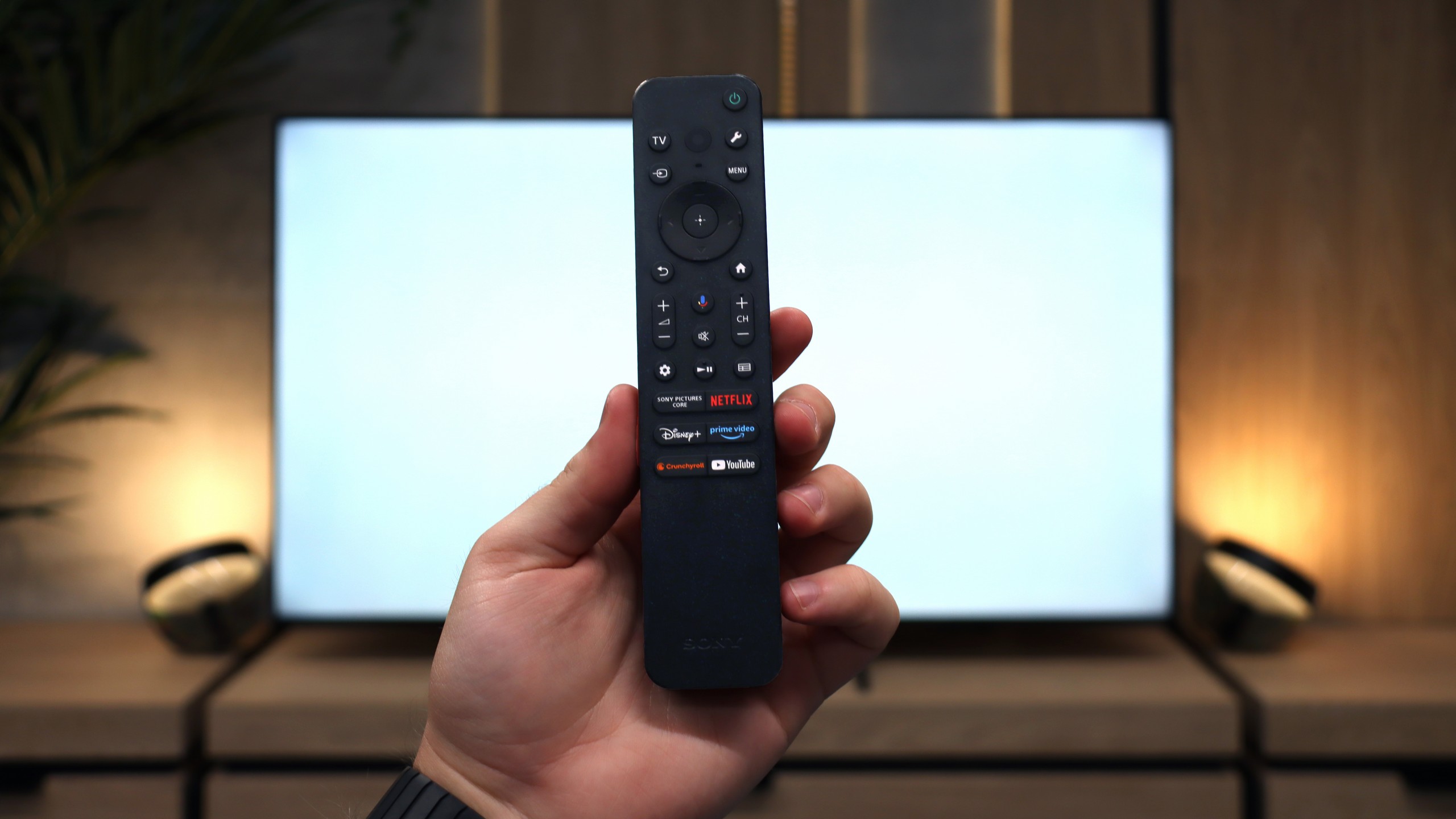
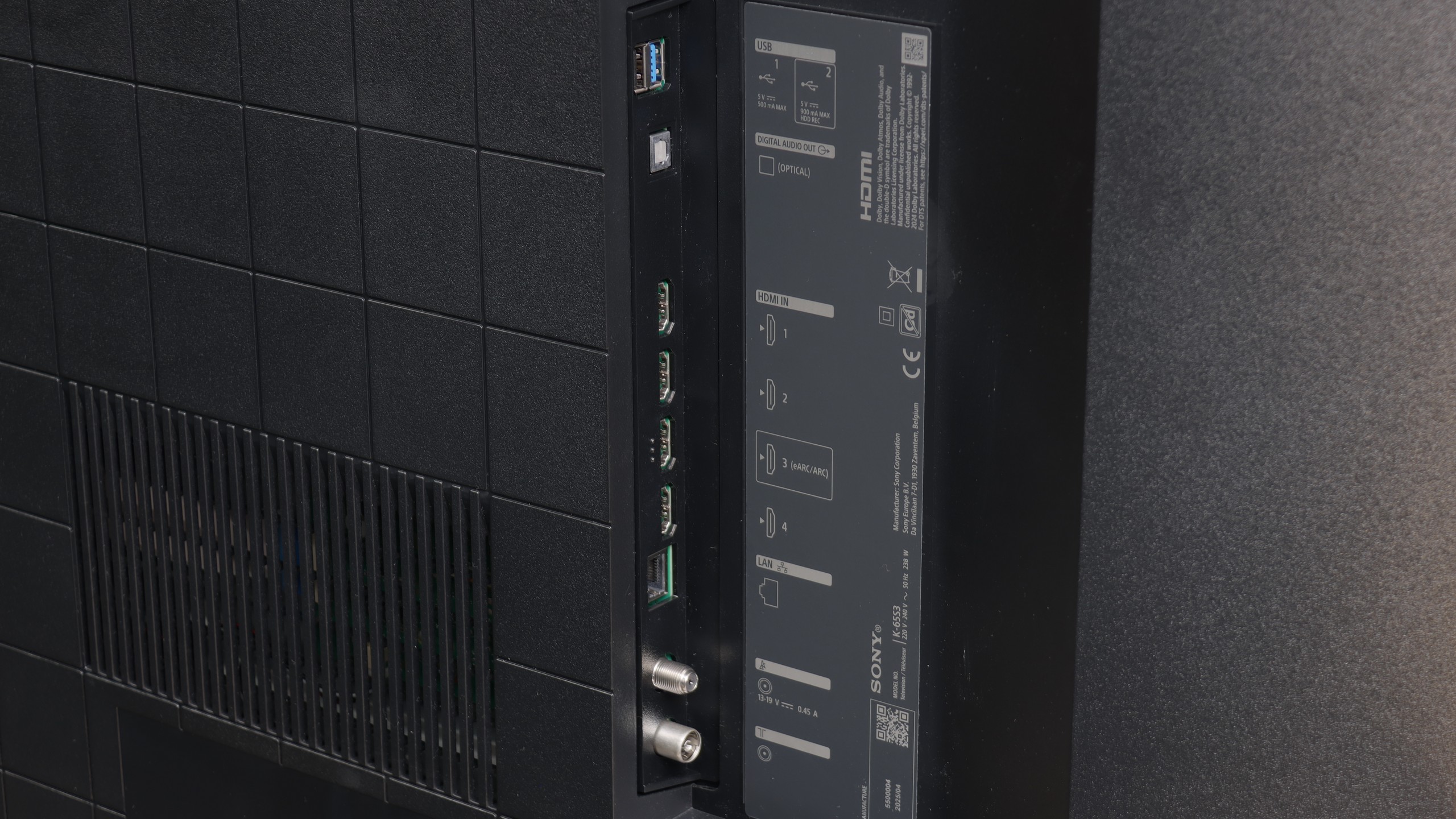
Samsung S85D operates on the Tizen operating system, which is intuitive and provides easy access to numerous applications and streaming services. The system offers smooth and quick navigation, significantly enhancing the comfort of using the television. The television is equipped with a solar remote control that allows the operation of other devices, such as set-top boxes or home theatre systems, enabling control of all home equipment with a single device. In terms of connectivity, the Samsung S85D supports AirPlay, facilitating content sharing from Apple devices, and includes a built-in Bluetooth module, allowing for the connection of peripheral devices such as keyboards, headphones, or speakers.
When it comes to everyday use of the television for regular TV, the S85D model offers several useful features but also has certain shortcomings. One of its advantages is the PIP (Picture-in-Picture) function, which allows simultaneous viewing of two content sources – for example, a match in a small window while the rest of the screen displays a favourite series. This is a convenient solution for those who want to stay updated with various programmes. However, the lack of recording capabilities from the built-in tuners is disappointing. This limitation means that favourite programmes or films cannot be saved for later, which may be an issue for those who wish to flexibly adjust their TV viewing to their schedule – however, we believe that the absence of this feature is becoming increasingly less burdensome, as users currently have wide access to various online content, making the need for recording less significant.
The design of the OLED Samsung S85D is distinguished by its characteristic rounded shape at the back, setting it apart from most OLED televisions, which typically have a flat rear. This unconventional design gives it a unique appearance and attracts attention, resulting in a television that looks modern and elegant. The package includes a remote control, a CI+ module, a stand in the form of two legs, and a power cable, allowing for a quick and convenient start to using the television without the need to purchase additional accessories.
Smart TV Features
The biggest advantage of the Bravia 3 in everyday use is the presence of the Google TV system. Thanks to it, we have access to one of the largest libraries of apps and streaming services, so regardless of whether someone mainly uses Netflix, Disney+ or smaller platforms, everything is within reach. The Google voice assistant also worked very well, managing to respond to our commands quite "cleverly". In theory, the Google TV system should operate very smoothly, as Sony has been implementing it better than many cheaper competitors for years. Unfortunately, in the case of the Bravia 3, it is not as great as we might have hoped. During testing, we noticed slight stutters in the interface, and some functions, such as screen mirroring, simply refused to work. One might get the impression that the processor in this model sometimes struggles to handle the demanding system, and not everything works as smoothly as we would expect.
Classic Features
Even in the cheapest series, Sony can remind us of its experience with various users. The set includes two remote controls. The first is modern and minimalist, with a small number of buttons, which works excellently for using apps and Google TV functions. The second is a classic remote with a richer set of keys and a numeric keypad, which will be especially appreciated by older people accustomed to traditional solutions. This is a nice nod towards different user groups, and it must be acknowledged that Sony has solved this very practically. It's a pity, however, that the ability to record content from TV tuners to USB memory has disappeared compared to the X75WL model. The manufacturer has completely eliminated this function, so if someone was attached to it, they will unfortunately not find it in the Bravia 3.
Playing files from USB
9.1/10
9.6/10
Supported photo formats:
Maximum photo resolution:

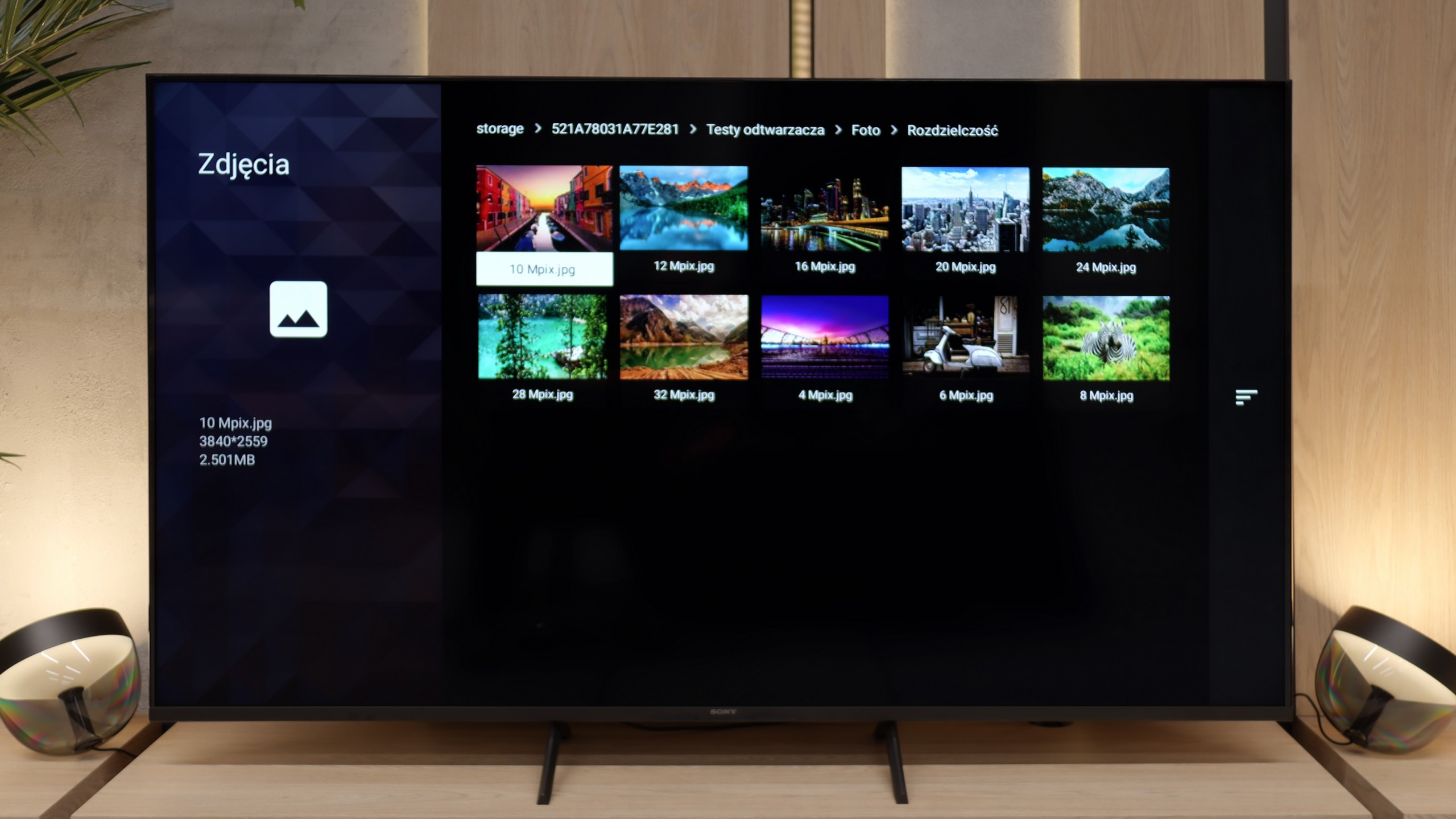
Playing multimedia files on the Samsung S85D will satisfy most users. The television offers wide compatibility with popular video, audio, and image file formats, ensuring smooth playback from both USB drives and the local network. The built-in media player operates efficiently and is user-friendly, although there may be issues with some less common formats.
Here Sony has really done a great job. The built-in player works quickly and doesn’t “complain” when launching various formats. We didn’t have to reach for external applications like VLC, as the television handled even files that can cause quite a few problems on other models – such as HEIC photos from Apple devices. It's a small detail, but one that shows the manufacturer wanted the user to have a complete sense of convenience. By plugging a film onto a USB drive or holiday photos onto an external hard drive, you can simply connect them and start watching on the big screen right away. No fuss, no installing additional software, no searching for workarounds. This is truly a rarity in televisions, and it must be admitted that in this aspect, the Bravia 3 really pleasantly surprised us.
Apps
8.7/10
9.6/10














































Sound
7/10
6.5/10
- Maximum volume-88dB
- Dolby Digital Plus 7.1
- Dolby True HD 7.1
- Dolby Atmos in Dolby Digital Plus (JOC)
- Dolby Atmos in Dolby True HD
- DTS:X in DTS-HD MA
- DTS-HD Master Audio
Samsung S85D OLED offers quite decent sound, although the built-in speaker set is not particularly impressive (2x10W). The television supports Dolby Atmos technology, which provides spatial sound, however, it does not support the DTS format. The sound is clear and sufficient for everyday use, although for more demanding users, it may be advisable to connect an external audio system to achieve a fuller and more dynamic sound.
Bravia 3 plays in a rather flat manner, but makes up for it with loudness. It is perfectly suited for watching classic television, as the dialogues are clear and the mid tones are easily heard. This type of characteristic will be particularly appreciated by older users who primarily value speech intelligibility. However, if someone expects something more from the sound, like stronger bass or a wider soundstage, it is still worth reaching for a soundbar. The television supports modern codecs, including Dolby Atmos and DTS:X, so an external sound system can easily take advantage of their potential. This assures that with a relatively modest expense, one can achieve a much fuller and more engaging sound.
Sound Quality Test
No sound test video
Acoustic Measurements
No acoustic data
88dBC (Max)
75dBC


